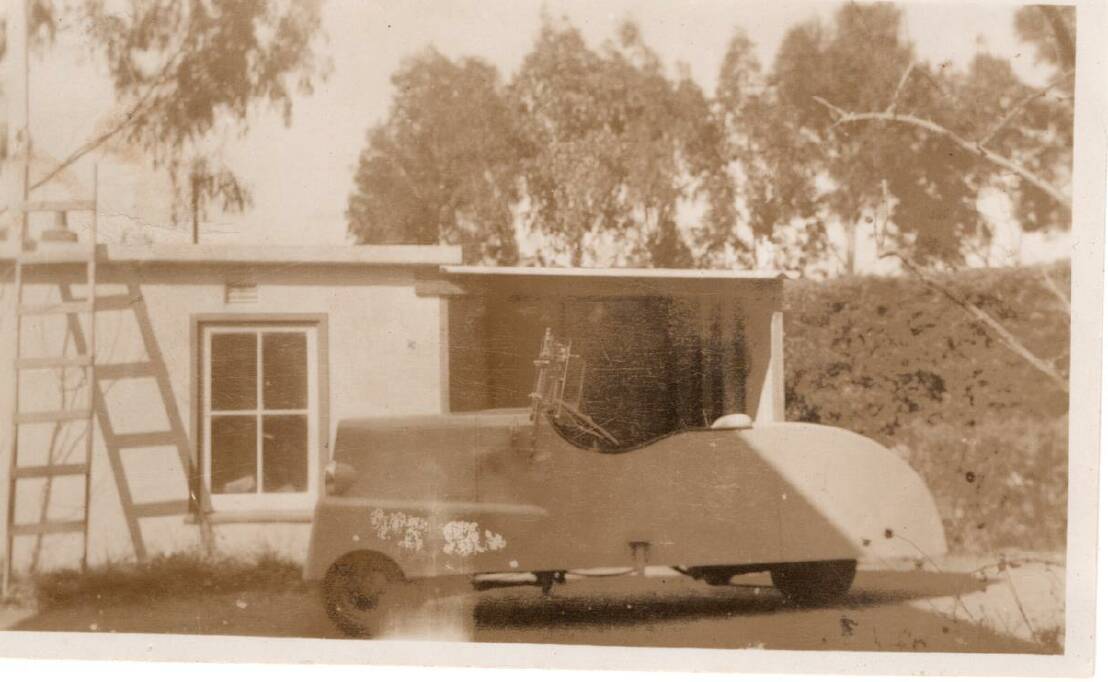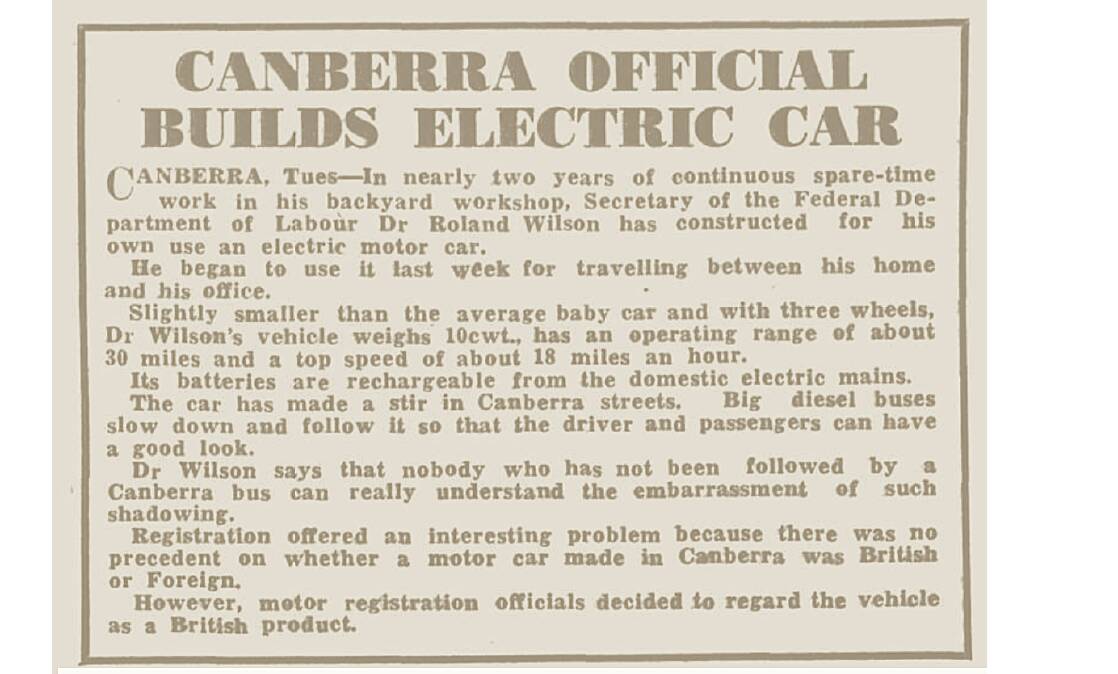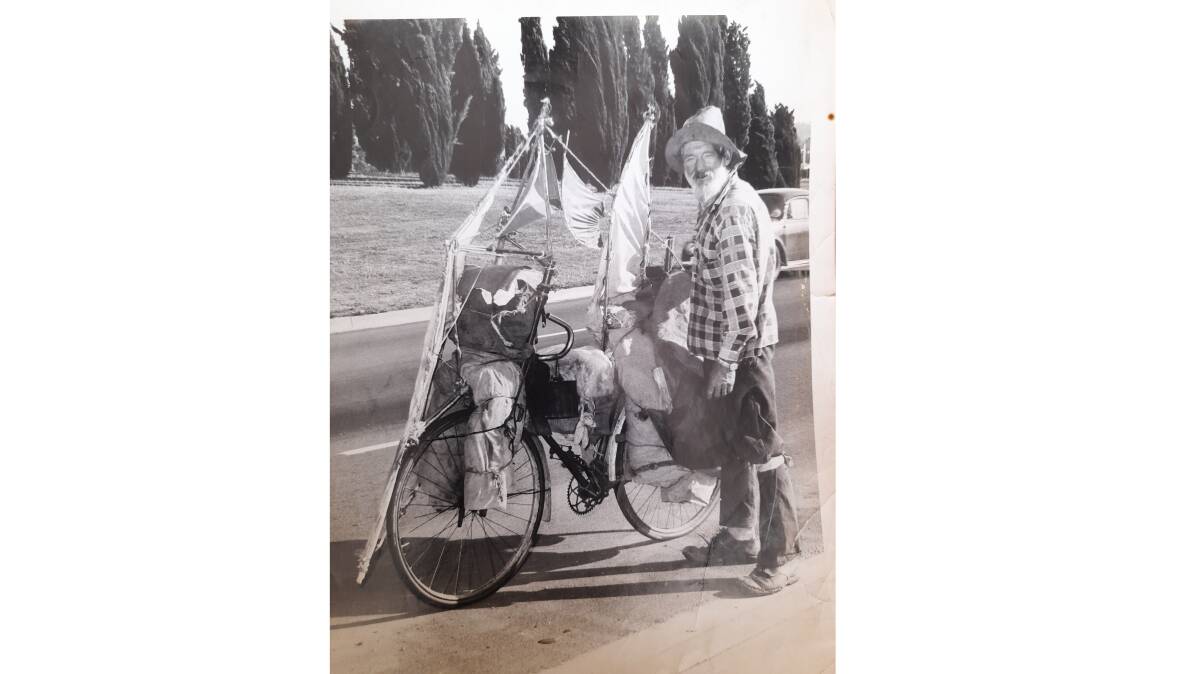
I recently drove an electric vehicle (EV) from Sydney to Victoria's Port Phillip Bay and back.
While meticulous planning ensured we had sufficient charging points along our route, by far the biggest eye-opener of the trip was the attention the vehicle received from bystanders.
I may as well have been behind the wheel of a motorised Loch Ness monster with neon lights because everywhere we stopped, car buffs would come from nowhere to take photos or pose a seemingly never-ending list of questions about the car's performance and battery range.
I guess the fact the car, a Hyundai IONIQ5, was recently named World Car of the Year and that they're as rare as hen's teeth in Australia didn't help.

However, this level of attention pales into insignificance when compared to the interest that bureaucrat Roland Wilson received when driving Canberra's first home-made EV between his home in suburban Forrest and his work in the Parliamentary Triangle in the 1940s.
Yes, 1940s!
It was during World War II when fuel in Australia became so scarce that many cars were temporarily stashed away in garages or converted to run using cumbersome charcoal-burning gas producers. Some horse-drawn vehicles even returned to the roads.
An economist by trade, the innovative Wilson, a Rhodes Scholar, built his car from bits and pieces collected from Canberra junk shops and rubbish tips. It boasted a top speed of about 20km/h and an impressive range of 49-64 kilometres between overnight charging of a line of 12 batteries stashed under the hood.

Although the IONIQ5 sports a space-age look, one can only imagine how modern Wilson's EV must have looked for the 1940s. Apparently, Wilson developed the sleek vehicle during lunch-hour studies of the new cars the American troops brought to Australia during the early years of the war.
Newspapers of the time reported bystanders stopping to gawk at his three-wheeled, open-bodied vehicle and Canberra buses slowing down so passengers could get a better view of Wilson's unusual set of wheels.
Your akubra-clad columnist wasn't even aware of Wilson's remarkable invention until an historic photo of the vehicle parked outside Wilson's former home in Forrest recently lobbed in my inbox. The photo was sent to me by Stan Bakker of Narrabundah who suspects his late mother, Vesper Margules, snapped the grainy photo while undertaking domestic work at Wilson's home in the early 1940s.

"My mother thought it ended up in some sort of car museum somewhere, it'd be good to know if it's still around," says Bakker.
Well, good news, this column can reveal that not only is the car still around, but it is part of the Powerhouse Museum's collection, expertly conserved for future generations to ogle over.
"It's got remarkable provenance," says Powerhouse Museum curator Damian McDonald.
"Wilson made the car in his Canberra backyard, using what he could find, he even had his own foundry where he cast parts of the car," reveals McDonald.
"In 1966 when Wilson was appointed chairman of Qantas, he brought the car with him," says McDonald, adding "he gifted it to the airline's apprentice training school and in 1974 it received its present Qantas livery.
"Afterwards it became a learning tool at the School of Applied Electricity at NSW TAFE which subsequently donated it to the Powerhouse Museum in 1978."
Wilson's EV has occasionally been dusted down to feature in temporary exhibitions, displayed as a static exhibit, but according to McDonald, "the right mechanical engineer could start it no trouble".
That said, it would need a different charger to that which Wilson engineered. "Unfortunately, the original charger went missing before the vehicle was donated to the museum," says McDonald.

McDonald also reveals the car was temporarily loaned to the ANU in 1999 to coincide with the opening of the Sir (he was knighted in 1955) Roland Wilson Building by then prime minister John Howard.
Does anyone remember seeing it in the foyer? Or better still, are there any photos of it driving on Canberra roads? I hope so.
Easy breezy rider

A faded black-and-white photo of Wilson's 1940s EV wasn't the only image of an innovative mode of transport to lob into my inbox in recent weeks.
While sifting through his late grandfather's photo collection, Nicholas Corby of Tumut found this photo of swaggie Ernie Maguire and his unique sailing bicycle, dating from November 1964.
The photo appeared in The Canberra Times on December 1, 1964, along with the caption: "For more than 40 years Mr Ernie Maguire, 63, has been travelling country roads. He has given away walking and humping his swag and today he travels pushing his bike or, if the breeze is favourable, sailing it. Apart from the sails, the chainless cycle carries about 200lb of gear. Yesterday Mr Maguire arrived in Canberra from Cooma. He is shown here on City Hill."

Corby reports that at the time, his grandfather, George O'Neill, wrote the racing news for the The Canberra Times and as a result was lucky enough to meet Ernie as he cycled his contraption through Canberra.
It turns out Maguire may have been onto something - in 2019, a crowd-funding page popped up for a start-up company in the US to develop a "CycleWing" - a retractable tail sail for bikes (which is yet to hit the market!).
A warning not to get sidetracked!

Several readers were heartened to read of the restoration of Gunning Railway Station (There's movement at the station), none more so than public transport aficionado Barry Snelson of Calwell.
"Old railway stations; I love them," gushes Barry, revealing that another of his favourites is Binalong.
"It's more secluded than Gunning as trains no longer stop there, but it has a large building on an island platform that once boasted a railway refreshment room," reveals Barry. "There are also reminders of the old days with large water towers for the steam engines."
Barry especially remembers one trip from Sydney to Harden, where he changed at Binalong for Young when he was about 15, back in the early 1960s.
"We were behind an old steamer, and she was having problems, blowing a lot of steam and slipping badly," recalls Barry. "We finally ground to a halt at Binalong and the engine was taken off and put into a siding."
While a replacement engine was sent from Harden, the passengers on Barry's train had a long wait on their hands.
Despite the temporarily engineless train still boasting a buffet carriage, according to Barry "a few of the older men decided to walk to the pub for a few drinks".
Mmm, I think you can see where this one is headed.
"The replacement engines arrived before expected, quickly coupled up and took off," reveals Barry, whose train "was blocking the main line and had to be moved ASAP".
"We got to Harden with about seven empty seats and most likely the blokes in the pub wondering what to do next," muses Barry, who hopes Binalong Station will one day be brought back to its former glory like Gunning Station.
WHERE IN CANBERRA?

Rating: Medium - Hard
Cryptic Clue: Shepherds beware
How to enter: Email your guess along with your name and address to tym@iinet.net.au The first correct email sent after 10am, Saturday May 28, wins a double pass to Dendy, the Home of Quality Cinema.

Last week: Congratulations to Janet Baumhammer of Isabella Plains who was first to identify last week's photo as Canberra's first department store, JB Young's store on the corner of Jardine and Giles streets in Kingston, photographed in 1926, a year after it opened. Janet reports her father Harry Trevillian "used to pump petrol from bowsers just along Giles Street at that time, and which if you look closely are just visible on the right-hand side of the photo".
Special note to June Smith of Page who reveals she worked in the office of JB Young's "over 50 years ago" and to Mike Edwards of Merimbula who reports his "mum used to work there in during the war". "Apparently there was an air raid shelter nearby - where the Kingston post office is now - and there were regular drills," reports Mike. I wonder if it's still there - perhaps in a concealed basement? Someone must know.
As to the car in the photo - I'm reliably informed by Charlie Tizzard of Queanbeyan that it's a Ford Model-T delivery truck. Not quite as aerodynamic as the IONIQ5 or 1940s electric car featured on the facing page.
Shell shock

While snooping around the Southern Highlands earlier this week, I noticed a fence line where 30-50 snails were attached to every wooden post. I've observed snails do this in warmer climates of Australia to avoid high soil temperatures, but I suspect on this occasion, it might be related to the heavily soaked ground from recent record rains.
CONTACT TIM: Email: tym@iinet.net.au or Twitter: @TimYowie or write c/- The Canberra Times, GPO 606 Canberra, ACT, 2601







